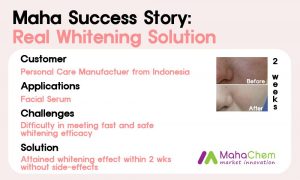
Success Story: How did our solutions result in the excellent whitening efficacy?
Our customer who is in the personal care industry in Indonesia wanted to achieve a distinguishing efficacy for its product. MahaChem provided the solution with the…
Skin aging is a natural process that occurs as we get older. The most prominent sign of skin aging is the appearance and deepening of wrinkles, as the skin becomes less elastic and more fragile. Production of natural oils from the middle later of skin (dermis) decreases, drying the skin and making it appear more wrinkled. Fat in the bottom layer of skin (hypodermis) diminishes, causing loose, saggy skin and more-pronounced lines and crevices.
Along with age, exposure to ultraviolet (UV) light also contributes to wrinkle formation, by breaking down the skin’s connective tissue — collagen and elastin fibres, which lie in the dermis. Collagen fibres provide support while elastin fibres provide flexibility and strength. Without them, the skin loses flexibility and strength and begin to sag and wrinkle.
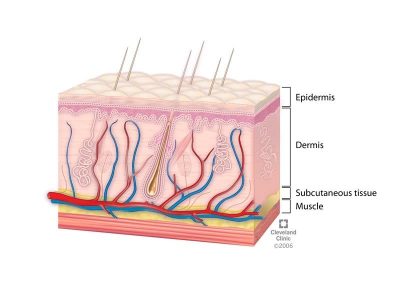
In this article, 2 different ingredients, C. rabens and GOS will be introduced. These ingredients can be added to beauty supplements to maintain skin beauty and health, and reduce wrinkles that are the most prominent sign of skin aging.
Crassocephalum rabens is a common herb conventionally used to treat inflammation-related syndromes in Taiwan. Studies have shown that C. rabens possesses anti-inflammatory and anti-cancer activities, contributed by the prominent active compound in C. rabens, a phytogalactolipid 1,2-di-O-linolenoyl-3-O-β-galactopyranosyl-sn-glycerol (dLGG) . Greenyn Biotechnology’s RabenWhite® contains the patented active compound CRK774TM, a standardised form of dLGG.
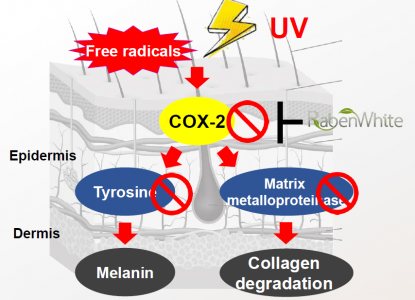
C. rabens contributes to skin improvement in two ways through a single mechanism, which is the inhibition of cyclooxygenase-2 (COX-2) expression, a key enzyme that causes inflammation. As COX-2 increases tyrosinase activity, the inhibition of COX-2 expression reduces tyrosinase activity, which in turn reduces melanin production. This leads to depigmentation, where the skin appears whiter and brighter.
COX-2 has also been shown to activate matrix metalloproteinases (MMPs) , also known as collagenases, a family of enzymes that break down peptide bonds in collagen and degrades it . With the inhibition of COX-2 by C. rabens, MMP activity is inhibited, hence decreasing wrinkle formation and collagen degradation.
The Ameliorating Effect of Crassocephalum rabens (Asteraceae) Extract on Skin Aging was studied by the R&D team at Greenyn Biotechnology. After 4 weeks of treatment with C. rabens, participants in the treatment group showed improvement in skin wrinkles, brightness, collagen content and UV spots as compared to participants in the placebo group.
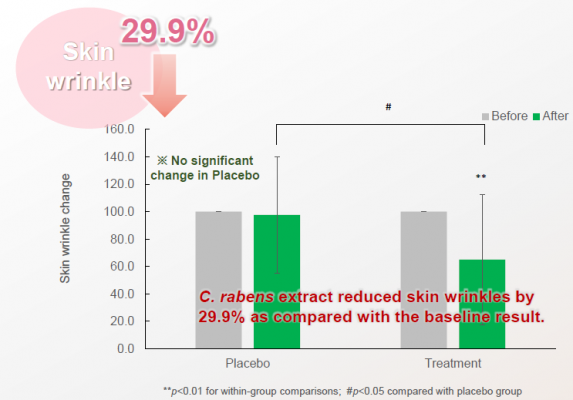
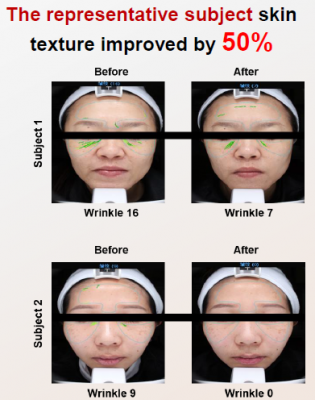
Wrinkle improvement in study participants
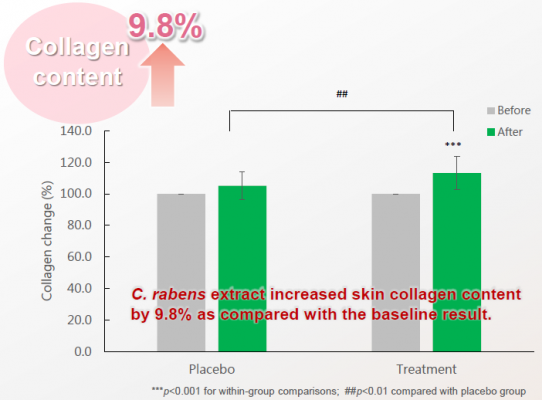
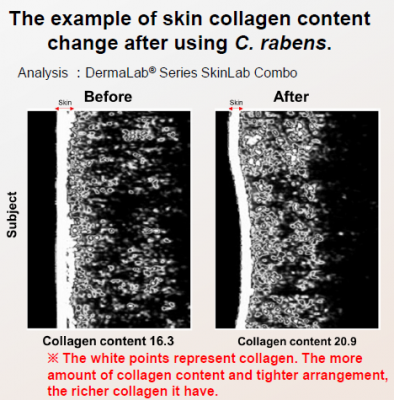
Increase in skin collagen content of study participants
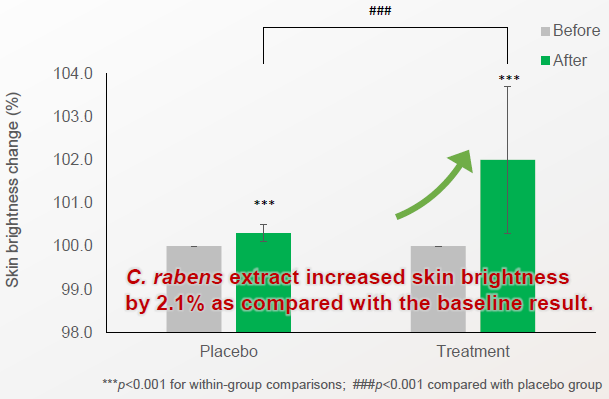
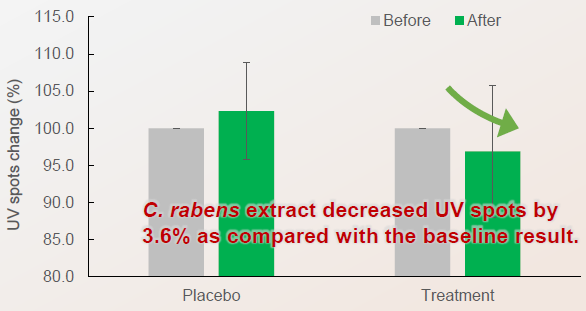
Enhance skin radiance of study participants
Galacto-oligosaccharides, or GOS in short, are non-digestible prebiotics composed of three to 10 molecules of galactose and glucose, produced commercially from lactose by β-galactosidase. GOS are known to promote digestive and immune health, as they pass undigested into the colon for beneficial gut bacteria to ferment them, the bacteria themselves proliferating and bringing benefits.
While prebiotics like GOS are primarily known for improving gut health, they also contribute to skin health through the growth of beneficial intestinal microbial flora. BeautyOLIGO® is a high purity galacto-oligosaccharide that improves intestinal regulation, strengthens the immune system and promotes biological activity. BeautyOLIGO® has also been verified to have skin improvement effects through animal tests and clinical demonstration.
Diet factors can cause skin troubles such as atopy, acne, dryness and consequent developing of wrinkles, by promoting rapid absorption of intestinal toxins produced by intestinal bad bacteria into intestinal mucosa, and transferring and accumulating them into the skin. BeautyOLIGO® strengthens the immune system by increasing intestinal beneficial bacteria, improve mineral absorption and eliminate toxins, which results in improvement of skin troubles and atopic disease by adjusting changes in cytokines, signalling materials controlling the body’s defence system.
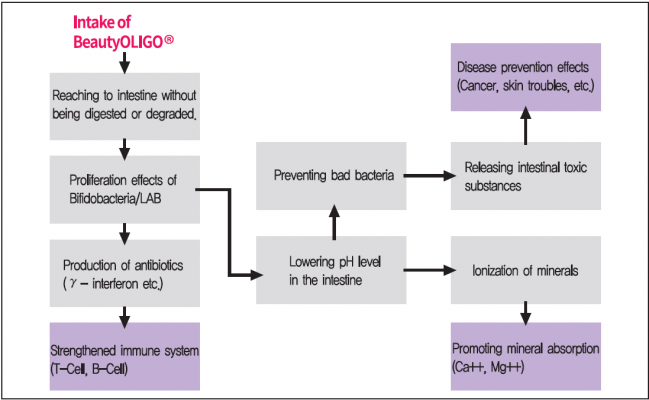
In the study Dietary galacto-oligosaccharides improve skin health: A randomized double blind clinical trial, the GOS group showed significantly greater increase in corneometer (measures hydration level of the skin) values from baseline to week 12, compared to the control group. The transepidermal water loss (TEWL), which refers to the water loss through the skin, was also reduced significantly after 12 weeks of GOS treatment. In addition, the wrinkle area was decreased significantly after 8 weeks of GOS ingestion. Meanwhile, the study of the Inhibitory Effect of Galactooligosaccharide on Skin Pigmentation showed that treatment with GOS reduced both melanin (skin pigment) index and erythema (redness of skin) index, hence GOS played a role in inhibiting skin pigmentation.
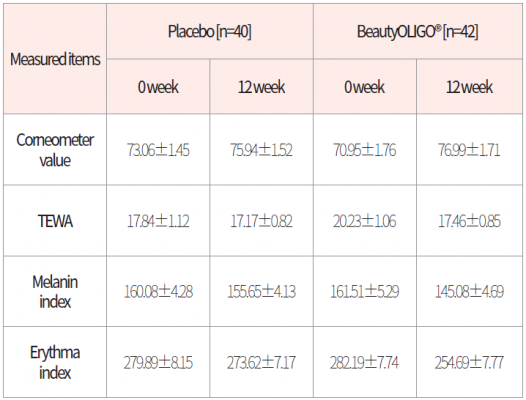
The table above shows the results of measurements, where the intake of BeautyOLIGO® improved water retention in skin and reduced skin pigmentation, thereby verifying the effects of moisture retention, whitening and erythema reduction.
If you are looking for anti-aging ingredients for your beauty supplements, try RabenWhite® or BeautyOLIGO®! Contact us at sales@maha.asia for further information regarding the product and quotation.
References:

Our customer who is in the personal care industry in Indonesia wanted to achieve a distinguishing efficacy for its product. MahaChem provided the solution with the…
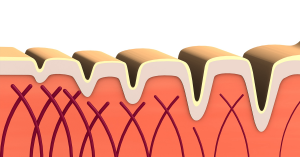
Are you looking for multifunctional moisturising agent? MahaChem provides Marine Collagen, which shows visible results in 1 week! Find out more about this innovative ingredient now.
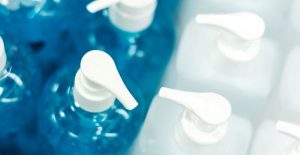
Some regularly used disinfectants are Benzalkonium Chloride (BKC), Didecyl Dimethyl Ammonium Chloride (DDAC), Dioctyl Dimethyl Ammonium Chloride (DODAC) and Chloroxylenol (PCMX). Learn more about them!
Copyright © 2023 Maha Chemicals (Asia) Pte Ltd